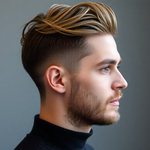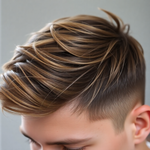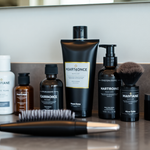
Color Anchors: Build a Low‑Waste Men's Capsule Wardrobe Around Semi‑Permanent Hair Color
29 August 2025
Share
Color Anchors: Build a Low‑Waste Men's Capsule Wardrobe Around Semi‑Permanent Hair Color
Struggling to look sharp without wasting cash or filling your closet with dead weight? Color anchors connect your semi‑permanent hair color to the clothes you wear, turning a few intentional pieces into a reliable, low‑waste men's capsule wardrobe. In this longform guide you’ll get step‑by‑step plans, shopping lists for different lifestyles, maintenance tips for both hair and garments, and concrete ways to cut waste while leveling up your look.
What are color anchors and why they work
Color anchors are two or three tonal references—usually one dominant and one accent—that you use to build and evaluate every purchase. When your semi‑permanent hair color is consistent, it acts as a visual anchor: outfits either harmonize with or deliberately contrast that hair tone. That consistency reduces decision fatigue, prevents pointless impulse buys, and makes a compact wardrobe feel far more versatile.
How semi‑permanent hair color changes wardrobe logic
Semi‑permanent hair color is flexible: it fades over time and can be refreshed or shifted without the commitment of permanent dyes. Use that flexibility to your advantage. Instead of matching a full closet to a wide range of possible hair tones, choose one color direction and build around it. If you like to switch hair tones seasonally, plan a small seasonal capsule swap rather than overbuying.
Color Anchors: Build a Low‑Waste Men's Capsule Wardrobe Around Semi‑Permanent Hair Color — a practical system
Here’s the blueprint you can follow literally this weekend:
- Pick your hair anchor: Choose the semi‑permanent shade you’ll wear for 6–12 weeks. Make sure it’s a tone you’re comfortable with—boldness is great, but consistency is key.
- Choose 1 dominant + 1 accent color: Dominant = jacket/outerwear/major pieces. Accent = shirts, knits, accessories. Keep one neutral (white/black/grey/beige) as common ground.
- Audit ruthlessly: Keep only items that work with at least two other pieces and your hair color. If an item fails the two‑pair test, sell or donate it.
- Buy with rules: New purchase must work with at least three items in the capsule and with your hair anchor. If not, walk away.
- Maintain and repair: Prioritize repairs and alterations over buying replacements.
Quick color guides based on common hair tones
- Dark brown / black hair: Works well with warm neutrals and rich jewel tones—navy, burgundy, forest green. Contrast is flattering.
- Warm auburn / copper: Olive, tan, denim, cream, and muted navy pair nicely—lean into earthy palettes.
- Blonde / ash blond / silver: Cooler neutrals and pastels—charcoal, slate blue, powder grey—create a modern, minimalist feel.
- Pastel or vivid semi‑permanent colors: Use muted neutrals and one echo color (e.g., pastel blue hair + navy + cream) to avoid looking too busy.
Capsule templates by lifestyle
Below are three tailored capsule lists (10–14 pieces each) you can adopt based on how you live and work. Swap colors to match your anchors.
1) Young professional (office + nights out)
- 1 tailored blazer (dominant anchor)
- 2 button‑down shirts (white + patterned/anchor)
- 2 crewneck tees (neutral + accent)
- 1 merino knit or lightweight sweater
- 1 pair chinos (neutral)
- 1 pair dark denim
- 1 pair leather boots + 1 pair minimalist sneakers
- Outerwear: versatile coat or jacket
- Accessories: belt, watch, one scarf in accent color
2) Creative / freelance (flexible, casual)
- 1 chore jacket or field jacket (dominant anchor)
- 3 tees (mix of neutrals + anchor)
- 1 casual button‑up (linen or cotton)
- 1 overshirt or light knit
- 1 pair tapered jeans
- 1 pair chinos (for meetings)
- 1 pair rugged boots + 1 sneaker
- Backpack or messenger bag in neutral
3) Active / travel (compact, durable)
- 1 weatherproof shell (dominant anchor)
- 2 quick‑dry tees (neutral + accent)
- 1 merino base layer
- 1 pair technical travel trousers
- 1 pair dark jeans
- 1 pair lightweight hiking shoes + 1 pair casual sneakers
- 1 packable down or synthetic jacket
Shopping guide: fabrics, construction, and sustainability
To build a low‑waste wardrobe, prioritize quality materials and construction. Here’s what to target:
- Natural fibers: Cotton, wool, linen and Tencel blend comfort and longevity when well made.
- Recycled materials: Recycled polyester can be durable and eco‑friendly when sourced responsibly.
- Stitching and hardware: Look for reinforced seams, quality zippers, and solid buttons—these small details dictate lifespan.
- Neutral cuts: Timeless fits age better than skinny or ultra‑oversized fleeting trends.
Menll.com offers several durable outerwear options designed with sustainability in mind—check the outerwear collection for pieces that fit the dominant anchor role and are built to last: Menll.com outerwear collection.
Styling rules that make mixing easy
- Limit prints: One patterned item per outfit keeps things coherent and compatible with your hair color.
- Contrast strategically: If your hair is dark, use lighter shirts to create separation. If your hair is light or pastel, use darker outer layers as anchors.
- Use accessories as small echoes: A watch strap, beanie, or scarf that shares the accent color ties a look together without overdoing it.
- Texture over color for interest: Use corduroy, ribbed knits, or suede to add depth when you’re keeping a restrained palette.
Hair care and color maintenance that supports the capsule
A consistent hair tone helps the color anchor system. Semi‑permanent dyes require less commitment but still benefit from routine care.
- Wash smart: Use cold or lukewarm water and a color‑safe, sulfate‑free shampoo to extend vibrancy.
- Refresh timing: Plan touchups every 4–8 weeks based on fade rate and how defined you want the anchor to be.
- Limit harsh chemicals: Avoid over‑bleaching and aggressive lifting if you want longer hair health and fewer corrections.
- Professional advice: For complex shifts (e.g., natural dark to pastel), consult a stylist to reduce damage and unpredictable fades.
For a clear primer on how semi‑permanent color works and safety considerations, see this WebMD overview: What is Semi‑Permanent Hair Color?
Packing and travel capsule tips
Travel is the ultimate test of a capsule wardrobe. Use these rules:
- Limit to 7–10 items if you’re doing carry‑on only.
- Choose layers that can be reheated for different climates: a neutral base, one anchor jacket, one knit, two bottoms.
- Bring multifunctional shoes—one pair you can hike in and wear to dinner if needed.
- Pack a small stain stick and a sewing kit to extend wear on the road.
Repair, tailor, recycle: the low‑waste playbook
Extending life is the most impactful sustainability move. Make these habits routine:
- Tailor first: A small alteration often makes an older item wearable again.
- DIY repairs: Learn basic sewing—replacing a button or patching a hem saves money and waste.
- Clothing swaps and resale: Sell items that don't match your anchors and reinvest in higher‑quality pieces that do.
Cost breakdown: Why fewer pieces can save money
Think of cost per wear. A $150 jacket worn 300 times costs $0.50 per wear. Five $30 trend pieces worn 10 times each cost $3 per wear. A capsule anchored to your semi‑permanent hair color encourages high use of quality pieces, reducing long‑term spend and landfill contribution.
Frequently Asked Questions
Can I switch anchors when my hair fades?
Yes. If your semi‑permanent color shifts, you can either refresh it to restore the original anchor or pivot to a nearby anchor and swap two or three pieces accordingly. Small seasonal changes are low‑waste compared to full closet turnovers.
How many colors should I have in my capsule?
Keep it tight: one dominant anchor, one accent, and one neutral. You can add one secondary neutral for depth. That gives maximum outfit variety with minimal purchases.
What if I like bold hair colors—can anchors still work?
Absolutely. Bold hair colors function the same way: choose a muted wardrobe palette that lets the hair be the focal point, and echo the hair color in a single accessory or small item to create cohesion.
Putting it into practice: a 30‑day plan
Follow this calendar to implement color anchors without overwhelm:
- Week 1: Choose your semi‑permanent shade and dominant/secondary anchors. Try a few outfits at home to test combos.
- Week 2: Closet audit—create three piles: keep, tailor/repair, sell/donate.
- Week 3: Buy one durable, versatile piece that fills a gap (e.g., a jacket or knit in your dominant anchor).
- Week 4: Finalize care habits—pick a color‑safe shampoo, schedule a hair touchup, and set repair/reminder tasks for garments.
Visuals and multimedia suggestions
Create simple visuals: a capsule grid showing 10 items with your hair photo, seasonal outfit tiles, and a travel packing list. If you use Jolt or an image generator, make images that emphasize clean lines and your anchor colors. Add alt text for accessibility describing the outfit and anchor color.
Final notes and soft call to action
Color anchors let you simplify, spend smarter, and reduce waste while keeping your style sharp. By aligning a semi‑permanent hair color with a small set of well‑chosen garments, you get more outfit options, less clutter, and a clearer personal brand. For reliable staples and sustainable outerwear that fit the dominant role in your capsule, check Menll.com’s outerwear collection: Menll.com outerwear. If you want a practical starting point, invest in one high‑quality jacket and one pair of versatile shoes—those two pieces amplify every anchor system.
Which anchor are you trying first—navy, olive, charcoal, or rust? Drop your pick in the comments, tag a mate who needs to downsize their closet, or browse Menll.com for pieces that match your new look.
Prev post

Match Your Mane: Use Semi‑Permanent Hair Color to Build a Sustainable Men's Capsule Wardrobe
Updated on 30 August 2025
Next post

Wardrobe Color Theory: How Semi‑Permanent Hair Color Optimizes a Sustainable Men's Capsule
Updated on 28 August 2025





